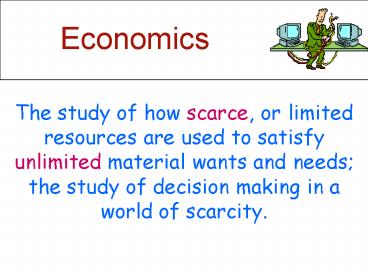Economics - PowerPoint PPT Presentation
1 / 30
Title:
Economics
Description:
Clothing (shirts, pants, blouses, shoes, socks, coats, sweaters, etc. ... environment open spaces, etc.) Pleasant working conditions. Limited Resources ... – PowerPoint PPT presentation
Number of Views:133
Avg rating:3.0/5.0
Title: Economics
1
Economics
The study of how scarce, or limited resources are
used to satisfy unlimited material wants and
needs the study of decision making in a world of
scarcity.
2
Unlimited wants
Limited resources to satisfy wants
Choose between alternatives
3
Scarcity
The result of not enough goods and services to
satisfy all human wants and needs.
4
Scarcity and Poverty
Absence of poverty implies some basic level of
need has been met.
An absence of scarcity would imply that all of
our desires for goods are fully satisfied.
We may someday eliminate poverty, but scarcity
will always be with us.
5
Scarcity and Choice
Scarce Goods
Limited Resources
6
Prices
Competition for scarce goods
Causes prices to change accordingly
7
guideposts
Principles or guideposts characterize the
economic way of thinking and are essential to
understanding the economic approach.
In fact
In fact
In fact
In fact
Once these guidelines are incorporated, we
believe that economics can be a relatively easy
subject to master. p 9
8
guideposts
1. The use of scarce resources to produce a good
is always costly.
- Someone must give up something if we are to have
more scarce goods. - b. The highest valued alternative that must be
sacrificed is the opportunity cost of the choice.
This class?
What must be given up to get one more unit of
another good or service
9
guideposts
2. Individuals choose purposefully therefore
they will economize.
Economizing gaining a specific benefit at the
least possible cost.
Consumers make rational decisions, based on costs
10
guideposts
3. Incentives matter
As personal benefits (costs) from choosing an
option increase, other things constant, a person
will be more (less) likely to choose that option.
11
guideposts
4. Economic reasoning focuses on the impact of
marginal changes.
Decisions will be based on marginal costs -the
cost of buying or making one more unit and
marginal benefits (utility). - The increase in
satisfaction from buying or making one more unit
12
guideposts
5. Since information is scarce, uncertainty is a
fact of life.
Everyone does not have access to the same amount
of information about prices and costs.
13
guideposts
6. In addition to their initial impact, economic
events often generate secondary effects that may
be felt only with the passage of time..
14
In an effort to promote energy conservation,
Congress mandates a minimum average gas mileage
that auto manufacturers must achieve for the cars
that they sell. Can you think of any secondary
effects of these mandates that will conflict with
energy conservation? With auto safety?
15
guideposts
7. The value of a good is subjective and varies
with individual preferences.
and uses!!!
16
guideposts
8. The test of an economic theory is its ability
to predict and explain events in the real world.
It is very difficult to predict human behavior
17
Thinking
Like an Economist!!!
1. Gather data
2. Study the data
Need facts to support theories and theories to
make sense of facts.
18
Methods
a. Inductive
Use facts to develop a model
Take a survey and study the results
b. Deductive
See if the facts support a hypothesis
Start with a theory and see if facts support it
19
3. Make Assumptions
a. Principle - relationship
b. Theory string of principles
c. Law theory proven to hold true most times
4. Form Policy!!!
20
Predicting Behavior
Positive Economic Statements - relationships
that can be tested - The class is half full -
Unemployment is 6 - if incomes rise people
spend money
21
Normative Economic Statements - statements
about what should be or make a value judgment
- It is too hot - Unemployment should be around
4 - we should raise the minimum wage.
22
Pitfalls
- Ceteris Paribus
- other things being equal
- - only consider price changes
23
Pitfalls
2. Cause and Effect one event may not be
the cause of another
- sunrise and the rooster
24
Pitfalls
3. Fallacy of Composition what is good for
some may not be good for others - increased
wages -time of this class
25
Presenting Data
- Table of Data
- -the Demand Schedule
- Graph
- -the Demand Curve
26
Economic graphs
- Independent Variable
- - Price, wages,
- - Y axis
- Dependent Variable
- - Quantity, workers,
- - X axis
27
Economic graphs
- Direct Relationship
- - Graph slopes up from left to right
- Inverse Relationship
- - Graph slopes down from left to right
3. Slope Rise Run
28
The Law of Demand
Other things being equal, as price
increases, the corresponding quantity demanded
falls
(price is the only variable that is changed)
29
The Demand Schedule
Selling Quantity Price
Demanded
10
5
4
15
3
25
2
40
1
60
30
The Demand Curve
Graphing
-Plot the points
Price
-Connect the dots
6
5
Downsloping left
to right
4
3
Demand
Demand
2
1
0
10
20
30
40
50
60
Quantity































